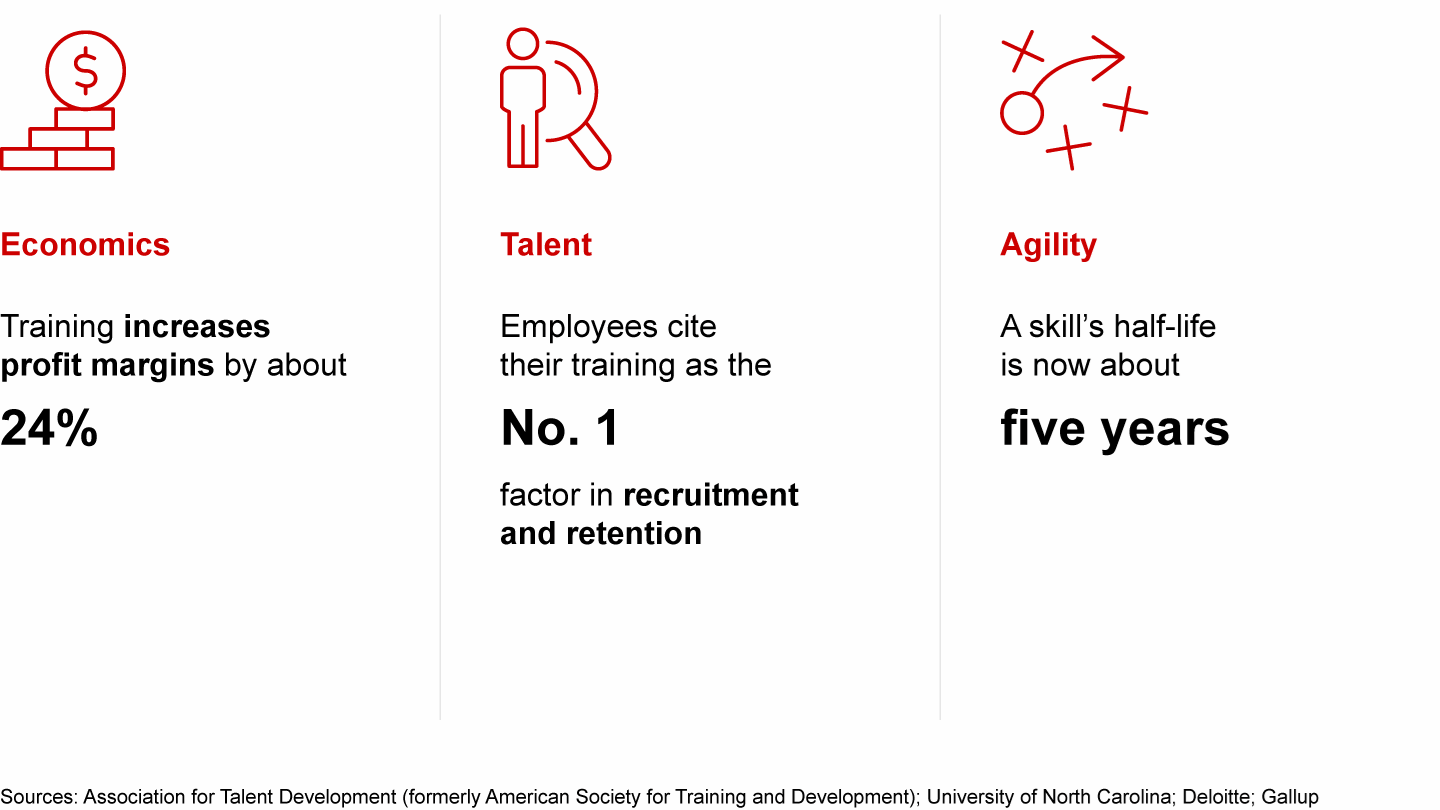Brief

Auf einen Blick
- The most effective programs combine three components—formal training, ongoing coaching, and peer learning—to create measurable, sustained improvement.
Practice makes perfect. That’s what parents tell their children, and they’re right. A typical Juilliard piano student needs to practice six to eight hours per day. Top college athletes in the US devote more than 35 hours a week to practice. Academics have even quantified how much practice it takes to master any skill: 10,000 hours.
Businesses see it, too. Employees get better at a skill when they apply it day in and day out. Along the way, it helps if they can learn from one another and receive timely reinforcement from experts about what they are doing right and what they are doing wrong. Unfortunately, when teaching new skills, many corporations throw all that insight away, organizing instead one-time training events that take employees out of the flow and offer neither sustained practice nor reinforcement. As a result, research has found that 90% of capability building programs are ineffective and do not lead to tangible business results.
It’s critical that businesses begin to fix that broken track record and train their workforces more effectively. Workplace skills are evolving quickly, employees are gravitating toward employers that offer learning opportunities, and even a modest investment in training can increase profits (see Figure 1).
Three factors are making employee training a pressing issue


Some leading companies have designed development programs that better align with how people learn. These companies combine three components consistently that together really have an impact.
- Reinvent the formal training approach.
- Coach in real time.
- Gather peers to reinforce and share experiences.
Here’s how this worked at one large industrial company. The company had been battling pricing volatility and high operating costs and determined that it had to reduce expenses between 15% and 20%. The company needed its people to develop new skills that would help it reduce cost, improve customer experiences and operations, and innovate fast enough to keep up with changing market conditions.
From the executive team through to the front line and across 150 specific transformation projects, the company implemented a three-step process of formal training, direct coaching, and peer learning.
The exact mix varied depending on the population undergoing training. Top leaders, for example, needed more coaching and peer learning, so they met monthly in order to collaborate and hold each other accountable on their goals—including improved problem solving, delegation, and ability to inspire, engage, and lead their teams. The central transformation team, by contrast, needed more training on skills such as writing a business case and the process for coming up with potential cost reductions, so they worked on those using a digital learning platform that enabled them to gather regularly into virtual teams of 5 to 10 people plus an expert coach, apply their new skills to individual initiatives, share best practices, and learn from one another.

Bain Academy℠
We provide customized learning experiences led by Bain experts who combine deep domain knowledge with real-world perspectives.
Reinvent the formal training approach
The foundation for acquiring critical new skills is formal training, and it works best when it’s fun, interactive, and filled with opportunities for practice and variety. That makes it memorable.
During a recent bootcamp that trained employees on Agile principles, one of the largest electric utilities in the US had participants walk into a room stocked with toy building materials, arts and crafts supplies, Koosh balls, and paper airplanes. In one exercise, employees worked in teams to build a model city. In another, they created a children’s book. This was all so far out of their typical work that it freed them to try new things. They saw the value of breaking work into short cycles, incorporating stakeholder feedback early and often, iterating on their innovation, and communicating frequently to remove roadblocks. Piloted with just two teams, more than 25 teams have now used the program. Within six months, 25% of the initial trainees moved on to new roles and opportunities, including promotions. Their teams have already unlocked savings to the tune of $30 million.
Coach in real time
During times of uncertainty and change, employees generally report lower satisfaction, but effective coaching can turn that around. Indeed, periods of change offer opportunities to apply and test lessons in real time, making them ideal moments to develop new capabilities. During transitions, people are hungry to learn. When employees are given effective coaching, those going through a significant change manage to grow their stress management skills 2.7 times more than employees who are not experiencing similar change, according to BetterUp, a fast-growing digital coaching and mentoring platform. Among coached leaders undergoing change, BetterUp has found that employee Net Promoter Scores—a measure of employee engagement and enthusiasm—grow 4.7 times faster than the scores of leaders not navigating change at all.
The importance of applying what’s learned in training and coaching was clear during a media company’s recent rollout of the Net Promoter System℠. The goal was to improve customer experience. Included in the training were technicians, a group who had long felt independent, a bit apart from the rest of the organization. Regular one-to-one coaching and team huddles with peer experience sharing helped them begin to see themselves as part of a team working together to make customers happier. During biweekly one-to-one coaching with their supervisors, the technicians hear positive feedback from customers and are given constructive criticism and the opportunity to discuss things that could have gone better. This positive reinforcement of the right behaviors and the retrospective on how to improve have helped the early technician participants climb from a negative Net Promoter Score℠ all the way to the positive 40s.

Ignite
Accelerate your change and transformation efforts with training tailored to the specific needs of your organization's leaders
Gather peers to reinforce and share experiences
As a team begins to apply what they’ve learned, it’s critical to gather back together to reflect on what’s going well and what’s been difficult. The media company’s daily team huddles offer every member the opportunity to share successes and customer experience lessons. Technicians take turns leading huddles, ensuring that they are invested in the process. Working together to identify themes and priorities to revisit in subsequent huddles helps to reinforce key lessons. Members report that engagement has skyrocketed.
They seem to have tapped into a deeper human tendency to retain motivation when undertaking an effort with peers. Researchers at Indiana University who study patterns of gym attendance, for example, found significantly higher monthly attendance among married couples than among people who had joined without their spouse. Dropout rates were much lower among married couples as well, 6% vs. 43%.
Digital platforms make it possible to connect more effectively, quickly, and frequently with peers and coaches across time zones. One energy provider recently used a digital learning platform to deliver new training, encourage peer learning, and provide expert coaching by pulling together people from across the organization to work on an array of digital initiatives. These included everything from improving field worker productivity to better tracking customer interactions, more efficiently maintaining key assets, and better predicting service interruptions. The three-step approach resonated with employees, 100% of whom reported improvement in digital skills focused on user centricity, design thinking, market orientation, Agile product development, stakeholder management, and data know-how. Since completing the program, 91% of staff are on track to meet their project milestones, twice the rate of teammates who have not yet undergone the training.
Conclusion
As these examples show, building capabilities requires pulling some levers, and the best results come when companies do three things in tandem. Formal training plus ongoing coaching plus peer learning is a training equation that adds up to measurable, sustained improvement.
Net Promoter®, NPS® und die NPS-bezogenen Emoticons sind eingetragene Marken von Bain & Company, Inc., Satmetrix Systems, Inc. und Fred Reichheld. Net Promoter Score℠ und Net Promoter System℠ sind Service Marks von Bain & Company, Inc., Satmetrix Systems, Inc. und Fred Reichheld.